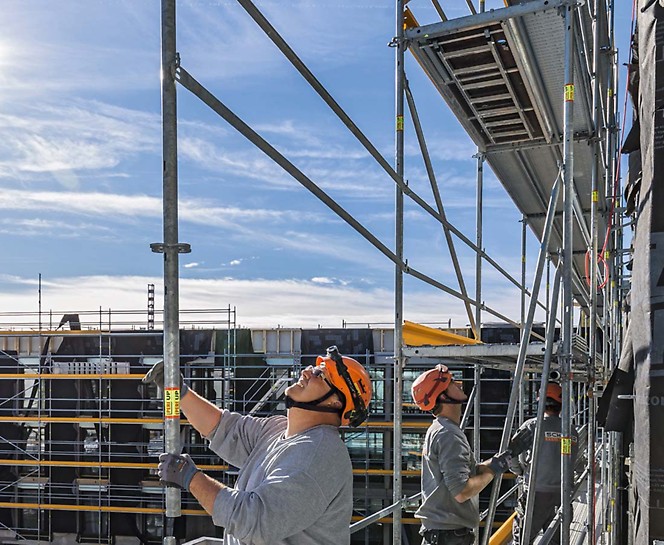The Conveniences of Scaffolding for Safety and Performance in Structure Projects
Scaffolding is a crucial element in the world of building, dramatically contributing to both safety and security and operational performance. By supplying secure platforms and boosted accessibility to elevated workplace, scaffolding not just alleviates fall risks but also enhances the workflow for construction teams. Its versatility permits for adaptation throughout different task types, guaranteeing compliance with safety guidelines. The influence of scaffolding extends past basic security measures; its strategic application can transform job timelines and outcomes. Checking out these complex benefits discloses understandings that are crucial for any kind of construction specialist.
Improved Employee Safety And Security

Boosted employee safety and security is a paramount issue in the building industry, where the dangers linked with drops and mishaps can have dire repercussions. Efficient scaffolding systems play a critical function in reducing these risks by offering stable systems for employees at elevated elevations. By making certain that scaffolding is effectively set up and preserved, construction companies can dramatically minimize the possibility of drops, which are among the leading reasons for workplace injuries and deaths.
Additionally, scaffolding boosts safety through its layout functions. Guardrails, toe boards, and non-slip surface areas add to a secure functioning environment, decreasing the risk of accidents. In addition, scaffolding allows employees to accessibility hard-to-reach areas without the demand for makeshift services, which can compromise security criteria.
Training workers on the correct use scaffolding is just as crucial. Guaranteeing that employees are knowledgeable regarding lots capacities, setting up treatments, and security methods even more improves the performance of scaffolding in preventing mishaps. Finally, incorporating robust scaffolding systems within construction projects not only enhances employee safety and security but also promotes a society of safety that benefits the entire workforce while improving general efficiency.
Improved Accessibility and Movement

Additionally, scaffolding permits for the hassle-free transport of products and tools, lessening downtime linked with relocating tools. Workers can effectively access different areas of a job, which is particularly essential in complicated builds where vertical and horizontal movement is frequent - Scaffolding. This accessibility not just improves operations but additionally makes it possible for groups to respond rapidly to changing project needs
In addition, scaffolding can be tailored to suit certain site conditions, boosting flexibility in uneven or limited spaces. This adaptability ensures that building and construction tasks can proceed efficiently, regardless of the challenges offered by the setting. By promoting improved accessibility and movement, scaffolding plays a vital function in sustaining building crews and maximizing the overall performance of building tasks.
Enhanced Task Effectiveness
In building and construction, job efficiency is dramatically influenced by the effective use scaffolding systems. By providing a secure and secure platform for employees, scaffolding reduces downtime and increases the pace of building and construction activities. With enhanced accessibility to elevated work locations, teams can complete tasks quicker, reducing the general job timeline.
The modular nature of modern scaffolding allows for quick assembly and disassembly, enabling speedy changes in between various phases of a job. This flexibility not just enhances workflow however likewise contributes to far better coordination among different professions, as numerous groups can function at the same time on different areas of a framework.
Furthermore, scaffolding guarantees that workers are positioned properly to do their tasks without unnecessary pressure or threat of injury, thereby decreasing the possibility of mishaps that can result in expensive delays. Enhanced security measures embedded in scaffolding systems, such as guardrails and toe boards, further assistance reliable procedures by preserving employee concentrate on the job handy as opposed to security worries.

Flexibility for Various Projects
Scaffolding systems attract attention for their flexibility across a vast array of construction tasks, efficient you could try this out in conference particular website demands and jobs. Their modular style permits for quick changes to fit numerous building kinds, from residential to business structures, making sure that workers have secure access at various heights and angles.
These systems can be tailored for varied applications, such as façade job, interior improvements, or heavy-duty commercial tasks. Lightweight light weight aluminum scaffolds are ideal for interior job, while durable steel structures provide the required support for large building. The versatility of scaffolding reaches its capability to be set up for both long-term and momentary frameworks, permitting professionals to effectively prepare and perform their jobs.
Additionally, scaffolding can be used in tough settings, consisting of city setups where room is restricted or on uneven terrain where conventional gain access to services are unwise. This versatility reduces the need for multiple access solutions, reducing expenses and job timelines. By fitting a range of tasks and problems, scaffolding improves the overall efficiency and performance of building and construction initiatives, confirming to be a crucial asset in the building market.
Conformity With Safety Criteria
Just how can construction jobs make certain the security of employees while keeping effectiveness? Governing structures, such as OSHA in the United States, offer standards that control the use of scaffolding, making sure that it meets strict safety and security criteria.
Proper scaffolding layout and installment play an important role in compliance. Scaffolds need to be created from top quality materials and created to hold up against the specific tons they will come across. Normal examinations and upkeep are important to make sure that these frameworks continue to be secure throughout the task period. Educating employees on secure scaffold usage and the relevance of conformity with security requirements additionally strengthens a society of security on-site.
Furthermore, paperwork and record-keeping scaffolding knowledge pertaining to safety examinations and employee scaffolding gi pipe training are essential. These methods not just show conformity but also provide accountability and openness. Eventually, by prioritizing adherence to safety and security requirements, building tasks can promote a safer job setting, consequently enhancing productivity and effectiveness without compromising employee security.
Conclusion
Finally, scaffolding functions as an important part in building projects, significantly boosting safety and performance. Its style attributes, including guardrails and non-slip surface areas, add to a more secure working environment while promoting improved accessibility and wheelchair for employees. The modular nature of scaffolding promotes quick setting up, therefore raising overall task efficiency. Adherence to safety and security standards highlights the value of scaffolding in accomplishing successful project results, making it crucial in the construction industry.
Scaffolding is a vital part in the realm of construction, significantly contributing to both safety and security and functional performance. The effect of scaffolding expands past standard security procedures; its tactical implementation can transform task timelines and end results. In final thought, incorporating robust scaffolding systems within building and construction tasks not only improves employee security however also advertises a culture of safety that profits the entire workforce while enhancing general efficiency.
In verdict, scaffolding serves as an important component in structure projects, considerably boosting security and efficiency. Adherence to safety and security requirements underscores the relevance of scaffolding in accomplishing successful job outcomes, making it crucial in the building sector.